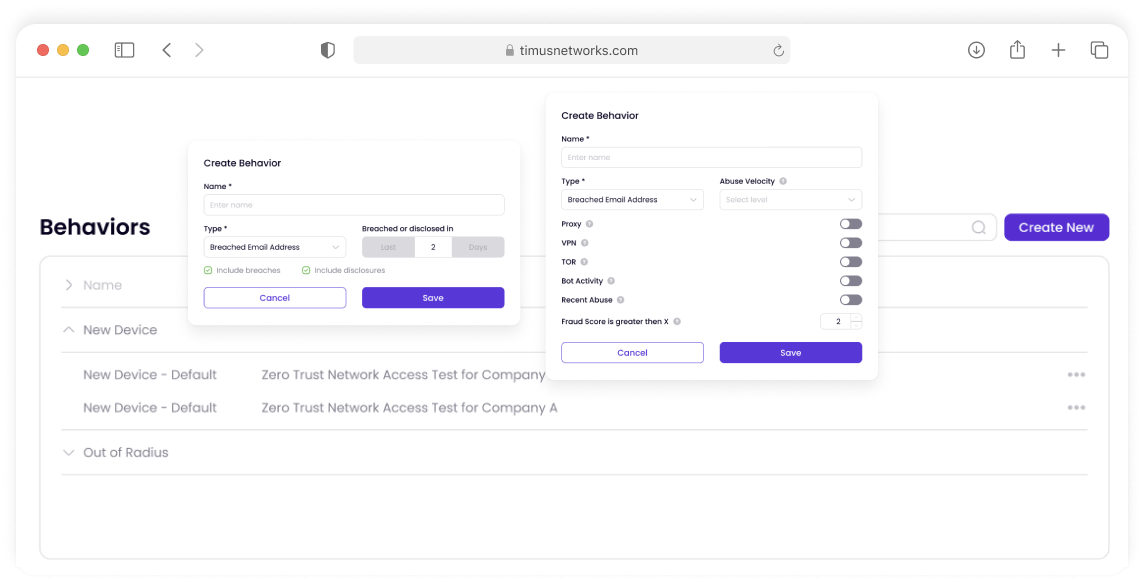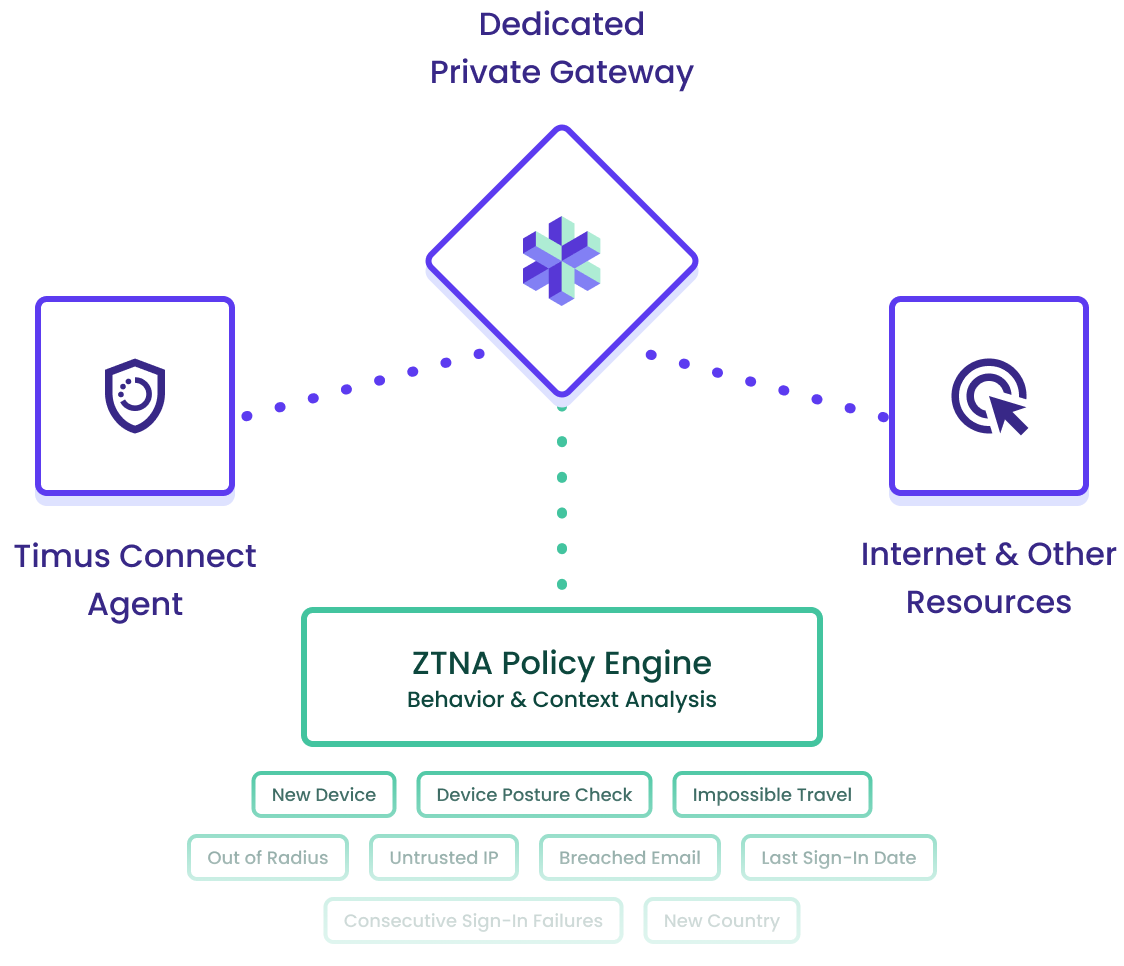Never Trust, Always Verify
Timus provides secure, always-on connectivity with a rich set of behavior driven conditional access policies based on Zero Trust Network Access.
30 days free with a Satisfaction Guarantee


Identity is the New Perimeter
Prevent Data Breaches with Timus ZTNA
Unlike traditional VPNs, Timus thoroughly verifies the identity of the user before granting access, and only to resources the user is authorized for. No random lateral movements once inside.
Reduce Your Attack Surface
Security is no longer confined to the office walls behind the firewall. A single point of network entry is critical.
Control Access to SaaS
Apps
Timus provides a Static IP address for its dedicated client gateways and cloud firewall. Leveraging a dedicated static IP address to restrict access to SaaS apps offers maximum network control.
Protect Employees, Wherever They Work From
With 48 global points of presence, Timus ensures remote connections, be it at a home office, coffee shop, airport, or a conference, experience maximum speeds, regardless of their location.
Any Device, Anywhere
The lightweight Timus Connect Agent is OS-agnostic, and supports Windows, Mac, iOS, and Android. It can be configured to be always-on, minimizing gaps in security.
Rules Follow the User
Timus ZTNA users connect through private, never shared cloud-hosted gateways. Timus Gateway can connect via IPsec tunnels to AWS, Azure, GCP & all on-premise firewalls.
Policies Enhanced by Dynamic Tagging
Automated micro-segmentation and continuous monitoring significantly reduce the attack surface and minimize the impact of potential breaches.
Adaptive MFA
Timus leverages behavioral analytics to scan user access requests based on contexts and risk level. MFA is pushed adaptively.
Key Behaviors – Impossible travel, new device, and many more.
Always-On Connectivity
The Timus Connect agent is easily configurable to stay connected at all times. Always-on can be enforced based on user, device and tag.

Speed Improvement
With 48 global PoPs to choose from, admins can ensure that users can expect stellar stability and performance.
Micro-segmentation
Implement least privilege access control via Timus with granular access policies which enable the creation of micro-segmented networks.
FAQ
Yes. Timus offers an award-winning Zero Trust Network Access (ZTNA) solution that has one of the most comprehensive checklists for behavioral context before it grants access to a user. The Timus ZTNA includes identity-based verification, Adaptive MFA, and intelligent threat detection via an adaptive cloud firewall. The Timus ZTNA eliminates the need for VPNs, offering always-on, secure connectivity.
Zero Trust Network Access (ZTNA) is based on the “never trust, always verify” principle, implying that trust is never granted before completely verifying. Access is granted granularly on the least privilege principle, where a user can only access explicitly authorized resources and data. ZTNA is one of the core components to providing secure, always-on connectivity to remote users, or users who are accessing SaaS apps on company devices.
Like all cybersecurity solutions, you don’t need them until you do and then it’s too late. ZTNA helps protect your network against ransomware and other nefarious attacks. One of the biggest weaknesses in modern cybersecurity defenses is the human element. If access to your network relies on credentials alone, you’re only one human error away from getting your data hacked or worse. The Timus ZTNA helps prevent access to precious company resources from unwanted third parties.
There are several disadvantages to VPNs that Timus solves by eliminating them with ZTNA.
1. Traditional VPNs are clunky
2. They are not always-on
3. VPN credentials are easily stolen by social engineering and phishing
4. A hacker can move laterally within the network via stolen VPN credentials.
Timus ZTNA allows users to access company resources in a granular way with secure, always-on connectivity through a lightweight OS-agnostic agent.
Zero Trust and Privileged Access are related but distinct security concepts. Zero Trust is a security framework that requires all users—whether inside or outside the organization’s network—to be authenticated, authorized, and continuously validated before accessing any resources. It operates on the principle of “Never trust, always verify,” ensuring that trust is continuously re-evaluated throughout a session. Privileged Access, on the other hand, focuses on granting specific users elevated permissions to access sensitive resources or perform critical functions. It involves managing, monitoring, and limiting these high-level permissions to minimize the risk of misuse.
Implementing Zero Trust enhances your organization’s security by reducing the risk of data breaches and unauthorized access. In a Zero Trust model, every access request—whether from inside or outside the network—is continuously verified, ensuring that only authorized users can access specific resources. This approach prevents attackers from moving laterally within the network, mitigates insider threats, and strengthens data protection.
The core principles of Zero Trust are:
Verify Explicitly: Always authenticate and authorize every access request based on factors such as identity, device health, data classification, and network location. This ensures that only verified users and trusted devices can access specific resources, minimizing the risk of unauthorized access.
Least Privilege Access: Enforce the principle of least privilege by granting users, applications, and devices only the minimum level of access necessary to perform their tasks. This reduces the attack surface and helps limit the potential damage in case of a breach.
Assume Breach: Operate with the mindset that a breach could happen at any time. By assuming breach, you can proactively limit the blast radius of attacks, segment access, and implement advanced monitoring and response mechanisms to quickly detect and contain threats.
Continuous Monitoring and Analytics: Implement continuous monitoring to detect unusual behavior, anomalies, or potential threats in real-time. Zero Trust emphasizes ongoing vigilance, using telemetry and analytics to detect and respond to security incidents promptly.
Automated Threat Response: Use automation to accelerate threat detection and response. By integrating Zero Trust with automated security solutions, organizations can quickly react to security incidents, limit potential damage, and reduce response time.
Microsegmentation: Break the network into smaller, isolated zones, where access to each zone is controlled and monitored. Microsegmentation minimizes the ability of attackers to move laterally within the network once inside.
Get Started with Timus
Zero Trust. Adaptive Cloud Firewall. Secure Remote Access. In one.